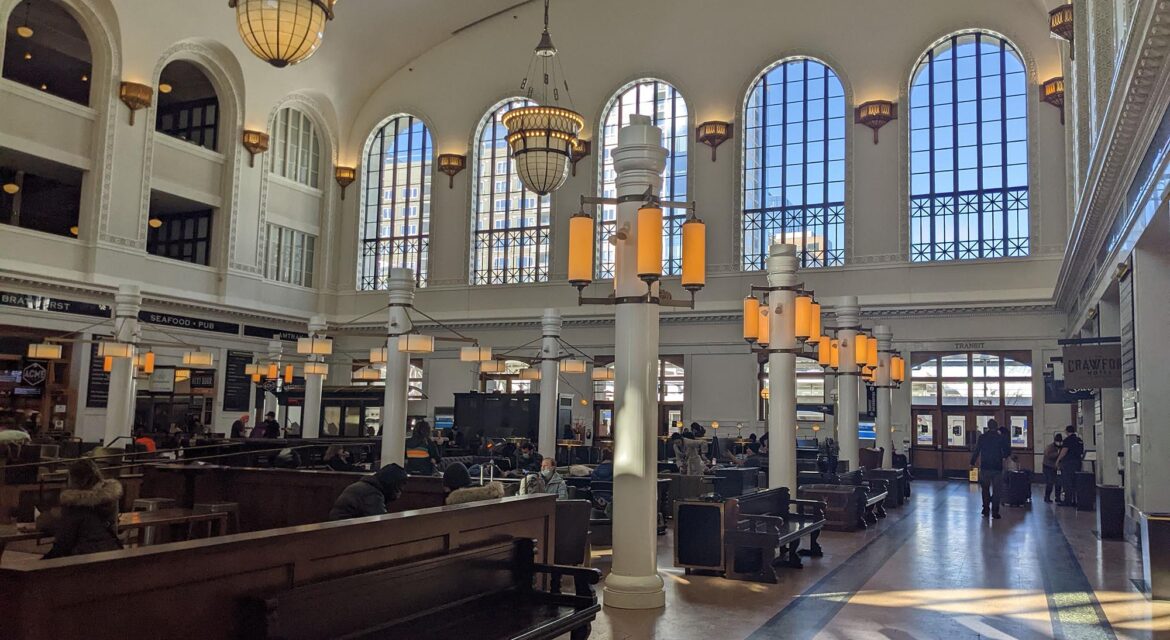 As the city of Denver’s first significant transportation hub, Union Station is an important piece of Colorado and United States history. The facility helped connect the country and stimulated the growth of Denver but changes to how people traveled meant that it fell into disuse. Instead of being disregarded, the building has been transformed into a different kind of hub for the modern community, compelling growth for the city in a whole new way.
As the city of Denver’s first significant transportation hub, Union Station is an important piece of Colorado and United States history. The facility helped connect the country and stimulated the growth of Denver but changes to how people traveled meant that it fell into disuse. Instead of being disregarded, the building has been transformed into a different kind of hub for the modern community, compelling growth for the city in a whole new way.

Denver’s “Living Room”
 The original Denver Union Depot opened its doors for the first time in 1881 and literally put Denver on the map, serving as an important destination for train travel to the West. This building would be lost to a fire which would eventually open up an opportunity for a Beaux-Arts and Renaissance Revival-style building, made of carved granite and terracotta. The newly-dubbed Denver Union Station reopened its doors in 1914.
The original Denver Union Depot opened its doors for the first time in 1881 and literally put Denver on the map, serving as an important destination for train travel to the West. This building would be lost to a fire which would eventually open up an opportunity for a Beaux-Arts and Renaissance Revival-style building, made of carved granite and terracotta. The newly-dubbed Denver Union Station reopened its doors in 1914.
The Great Hall helped to bring major opportunities for the city during train travel’s glory days in the 1920s. In 1952, the neon sign that read “Union Station – Travel by Train” was added to the façade, fully cementing the look of the monument.
The 1950s saw a sharp decline in service for Union Station as a result of options created by airlines and automobiles. Service at Union Station gradually dwindled and for a time it appeared the building would be demolished. In 2001, the station was purchased by a Regional Transportation District (RTD)-organized group. That was the beginning of a process to transform the space on multiple levels.
The entire site was redeveloped as the hub of a multi-modal transportation network with transit-oriented private development. The majority of the terminal building’s upper levels became the 112-room Crawford Hotel while the Great Hall became “the city’s living room” open to travelers, visitors and hotel guests at all hours of day and night, 365 days a year.
The station officially reopened its doors in 2014, exactly 100 years after the opening of the 1914 structure. With it came a variety of new opportunities to engage the modern community.

Shopping, Events and Activities
 After being fully transformed, Denver Union Station features an array of the city’s top local restaurants, bars and shops. Colorado-curated retail is located throughout the Great Hall with shops that sell everything from books to jewelry to custom gifts. The Crawford Hotel anchors the space in more ways than one.
After being fully transformed, Denver Union Station features an array of the city’s top local restaurants, bars and shops. Colorado-curated retail is located throughout the Great Hall with shops that sell everything from books to jewelry to custom gifts. The Crawford Hotel anchors the space in more ways than one.
Union Station also hosts signature events throughout the year, ranging from concerts to festivals. The facility accepts corporate sponsorships, creating a powerful source of revenue. It also contains multiple venue spaces that can host private corporate meetings, receptions, wedding rehearsal dinners, farewell brunches, and other celebrations.
To highlight how it has become part of the modern community, Union Station hosts Farmer’s Market from May through October every Saturday. Union Station is also the site of Denver’s latest urban beekeeping program, with four hives located on the roof of the building.
As a transportation hub for RTD’s front-range bus route, the free 16th Street Mall shuttle and the free Downtown Denver Circulator, Union Station has been able to retain a connection to its transportation roots. Doing so highlights how such a seismic transformation can reimagine opportunities for a space while also creating brand new ones.

Denver Union Station Reimagined
 Mentioned as the cultural hub and “crown jewel” of Denver, Union Station has transformed a piece of regional history in a way that both preserves and evolves the legacy that it represents. This transformation showcases what it can mean for something that might otherwise be displaced or discarded to instead become an essential element of the present and future of an entire community.
Mentioned as the cultural hub and “crown jewel” of Denver, Union Station has transformed a piece of regional history in a way that both preserves and evolves the legacy that it represents. This transformation showcases what it can mean for something that might otherwise be displaced or discarded to instead become an essential element of the present and future of an entire community.

